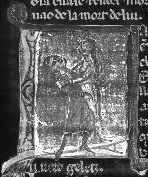

 The romantic idea of the troubadour current in the 19th century is slowly fading before a more
careful and realisitc appraisal built up by scholars over the years. Far from being a carefree
vagabond 'warbling his native woodnotes wild', the troubadour was a characteristically serious,
well-educated, and highly sophisticated verse-technician. Guillaume IX of Aquitaine, generally
described as 'the first of the troubadours' was a duke, and his granddaughter, Eleanor of Aquitain,
married first King Louis VII of France, and soon afterwards Henry of Anjou, later Henry II of
England.
The romantic idea of the troubadour current in the 19th century is slowly fading before a more
careful and realisitc appraisal built up by scholars over the years. Far from being a carefree
vagabond 'warbling his native woodnotes wild', the troubadour was a characteristically serious,
well-educated, and highly sophisticated verse-technician. Guillaume IX of Aquitaine, generally
described as 'the first of the troubadours' was a duke, and his granddaughter, Eleanor of Aquitain,
married first King Louis VII of France, and soon afterwards Henry of Anjou, later Henry II of
England.BARDS | MINSTRELS | TROUBADOURS
Back to the Library.